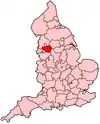Bee Network
The Bee Network is a proposed integrated transport network for Greater Manchester, composed of bus, tram, cycling and walking routes. Transport for Greater Manchester is expected to have the network operational by 2024, with commuter rail services expected to be joining the network in 2030. Initially revealed in 2018, the project is aiming to create a London-style transport system, to encourage more people to take public transport instead of cars.[1]

The network's main goal is to reduce the percentage of car journeys throughout the region from 60% to 50% by 2040.[2] The design of the network will be inspired around the Greater Manchester symbol, the worker bee, with bus and tram liveries coloured yellow and black to represent this.
History
The Bee Network was first proposed in 2018 by Chris Boardman, the region's walking and cycling commissioner, and former Olympic gold medalist. The original project would include 121 kilometres (75 mi) of segregated cycling lanes, brand new electric buses, around 2,900 kilometres (1,800 mi) of new dedicated walking and cycling routes, 2,400 new road crossings and a new cycle hire scheme throughout the region.[3][4]
In June 2022, Mayor of Greater Manchester Andy Burnham announced capped fares for buses from 2023 in order to help with cost-of-living rises. The new fares would see full day fares capped at £5, and single trips capped at £2.[5]
The first fleet of 50 Alexander Dennis Enviro400EV battery electric buses is intended to be rolled out across Bolton, Wigan and parts of Bury and Salford from 17 September 2023. Go North West and Diamond North West have been awarded two large franchises and seven small franchises, respectively, displacing the current operations of First Greater Manchester and Stagecoach Manchester in this area.[6][7] The fleet will be expanded by an additional 50 Enviro400EV buses in Oldham, Rochdale and the remainder of Bury in March 2024,[6][8] with bus operations in the rest of the city region becoming regulated by January 2025. These bus services will operate alongside the Bee Network cycle hire bikes and the existing Metrolink network.[9]
The cycle scheme launched in late 2021 using Beryl bikes.[10]
Design
The design of the network will be based around the worker bee. The worker bee is the most well known symbol representing the city and region, and was adopted during the industrial revolution. The liveries of the trams, buses and bikes will be yellow and black, representing the worker bee. The facilities supporting the network will also follow this design.[11]
See also
References
- "The Bee Network". TfGM Bee Active. Retrieved 2022-10-29.
- "Greater Manchester transport: Bee Network design revealed". BBC News. 2022-09-23. Retrieved 2022-10-29.
- "Manchester makes a Beeline for new Dutch-style cycling network". The Guardian. 2018-06-26. Retrieved 2022-10-29.
- "Bee Network explained to making getting from A to B easier in Bolton". The Bolton News. Retrieved 2022-10-29.
- "Greater Manchester capped bus fares could start in September, mayor says". BBC News. 2022-06-16. Retrieved 2022-10-29.
- Deakin, Tim (24 December 2022). "Go-Ahead wins initial Manchester large bus franchises". Route One. Archived from the original on 24 December 2022. Retrieved 24 December 2022.
- "Greater Manchester appoints first bus operators for new system". BBC News. 23 December 2022. Retrieved 24 December 2022.
- "TfGM orders 50 Enviro400EVs for Bee Network". Route One. 22 September 2022. Retrieved 22 September 2022.
- "New Details About Greater Manchester's Bee Network Transport System Revealed". Retrieved 29 October 2022.
- Cox, Charlotte (27 January 2022). "How is Greater Manchester's new bike hire scheme going two months in?". Manchester Evening News. Retrieved 22 March 2023.
- "Greater Manchester transport: Bee Network design revealed". BBC News. 2022-09-23. Retrieved 2022-10-29.
